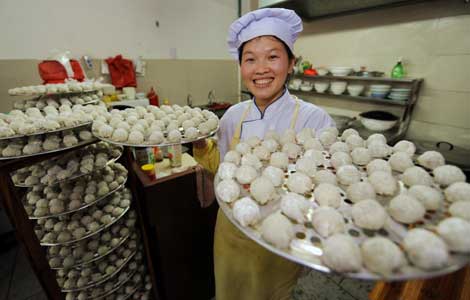Delicacies
Behind the 'secret ingredient' soup
Updated: 2011-06-04 08:11
By Wei Tian (China Daily)
|
A chef presents shaomai - a type of dumpling in Shaxian snacks. Provided to China Daily |
Fujian
For a traveler in a strange land, local feasts and rare delicacies are not always the best choice if one does not want to be ripped off or get sickened by unfamiliar food.
Before a heart-pounding adventure to the unknown, one should look for some fast and familiar taste to help calm the stomach.
McDonald's has not yet opened a branch in every tourist resort in China, but Shaxian Snacks, a Chinese restaurant chain which has about 10 times the number of franchises that the US fast food giant does, provides a homey and economic choice for tourists, especially for students and backpackers. Where else can you have a square meal for less than 20 yuan ($3)?
All Shaxian snacks restaurants are, and must be, opened by people from Shaxian county, Fujian province. A large proportion of the county's population is in the business, running more than 3,000 restaurants in nearly every major Chinese city.
Although most are not fancily decorated, a Shaxian Snacks restaurant is easy to recognize with the giant pottery jar in the front of the shop. The pot is the workshop and warehouse of one of its most popular dishes: stew pot soup.
Out of more than 100 choices on the menu, including steamed dumpling, wonton, sesame-buttered noodles and pressed salted duck, stew pot soup is a must-order which goes with every other dish.
Ordering in a Shaxian snacks restaurant never takes long - and for stew pot soup especially. It has been simmered for hours and is ready to eat at any moment.
The diligent chef normally starts preparing stew pot soup at 5 am, putting all materials together with some ginger slices and cooking wine into a pot. All the pots are placed in the giant pottery jar and the soup will be ready by lunch time. One pot sells for 6 to 8 yuan.
Served in a mug-sized pot, stew pot soup is clean and fresh, nothing more than some diced meat and odd-looking herbs soaked in broth. Despite the plain outlook, they are always given mysterious names, like Danggui (Chinese angelica root) Beef, Gouqi (wolfberry) Taihe Chicken, or Lianzi (lotus seed) Pork Tripe.
But after taking a careful sip of the hot broth, you will learn all the differences.
Hours of cooking has melded the flavors of all ingredients in the soup.
The beef dices will melt in your mouth very soon because of hours of stewing. (It can also be chicken, lamb, duck, seafood or meat balls, depending on which one of the fancy names you like.)
You will also taste something special, something herbal that is said to be the secret of the stew pot soup - the traditional Chinese medicine inside.
The weird-looking herbs highlight another selling point of stew pot soup - its magical curing power. For example, it is said that the danggui regulates your blood circulation, gouqi strengthens the immune system, and lianzi helps calm the nerves.
But all the fairy tales aside, I personally like the stew pot soup and Shaxian snacks restaurant just because they can be found in every city I have stayed in since college. It is still affordable even if I am nearly out of funds.
Once the warm soup enters the mouth, you feel like you are home and that may be the true secret of this "secret ingredient" soup.
China Daily
E-paper

Harbin-ger of change
Old industrial center looks to innovation to move up the value chain
Chemical attraction
The reel Mao
Improving app-iness
Specials

Vice-President visits Italy
The visit is expected to lend new impetus to Sino-Italian relations.

Birthday a new 'starting point'
China's national English language newspaper aims for a top-notch international all-media group.

Sky is the limit
Chinese tycoon conjures up green dreams in Europe with solar panels

